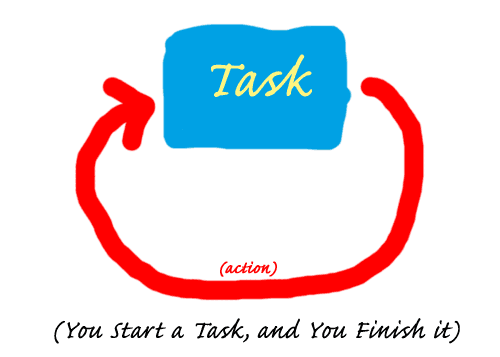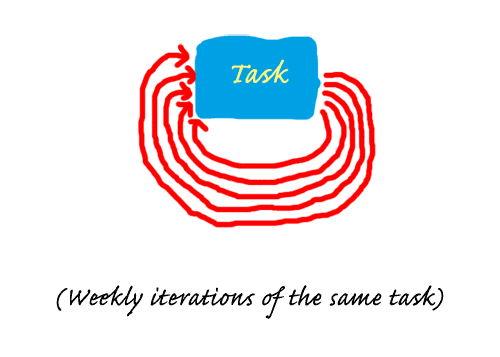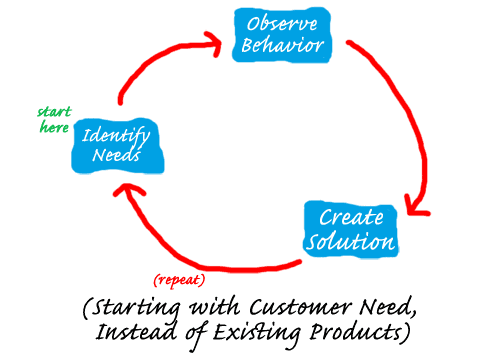Last week, I talked about streams that inundate your customers, your audience, and likely, your day as well. Today, I want to discuss barriers that prevent many businesses from creating sustainable revenue streams that are based on serving customer needs.
Lately, I have been rethinking everything about how I do my job. This is why:
- Many publishers have identified ways to engage an audience on the web, and to sustain this process.
- But many publishers have NOT identified sustainable ways to drive online revenue on the scale to which they have become accustomed.
My conclusion is that publishers are not in a paywall crisis – they are in a product crisis.
So I want to reshift my work day so that I am focused less on just one half of that equation (capturing attention) and more on integrated solutions: creating products that garner attention & solve needs, but also build sustainable revenue streams.
Below, I will take you along on this thought-process, with the goal of becoming better attuned to customer needs, more nimble in finding ways to serve those needs, and with a strong eye on creating products that support the business as well.
The Problem With the Way We Work
For the average worker, their day is filled with a thousand tasks, and I imagine the process for each one looks somewhat like this:

This could be editing an article, formatting a newsletter, preparing graphics, etc. Over a monthly or yearly time period, attention to this task might look like this:

As an example, let’s assume the task is to write an article about how the green movement is affecting your industry. Sustainability has become a huge topic, so three months back, your team made the decision that a weekly column would be warranted due to the growing conversation within your industry. So each week, you fill the "Green Article Bucket:"
Each Tuesday, you write the article, publish it in print and online, include it in a newsletter, and maybe you Twitter the link out to your followers. A job well done, and next week, you will repeat the process.
But wait… perhaps you do more. Perhaps you check your web performance metrics once a month, and maybe you even include a question in your yearly reader survey about their needs for green-related content. Likely, when you attend industry events, you might bump into a few folks who say that they love your columns. So that process might look a bit more like this:

And this is a problem. As reader behavior changes, as new competitors show up each month, as the business of publishing continues to be expensive, but revenue becomes more questionable, this is a problem. Here’s why:
- The voice of the customer is not an integral part of every action. As the web reshapes their behavior and how their needs are met, it is increasingly important to understand the nuances of these changing needs and behaviors.
- Doing the same thing, just more of it, will likely not deliver the exponential growth that you need.
- A strategy of Do, Do, Do, Do is not really a strategy at all, it is a series of tactics, one after another. A brand that follows this line of thinking misses new opportunities because they check-in with customers too infrequently, and reshift product strategy more slowly than increasingly nimble competitors.
Doing vs Listening
For many publishers, even B2B publishers, providing "coverage" of their industry is becoming harder to monetize. Reporting alone, and matching advertising next to it, will likely not be able to sustain a recognizable model of publishing in the near future.
I don’t say this to be negative, I say this because I am seeing newspapers close with greater frequency; because magazines are closing with greater frequency; because publishers are shrinking; because online advertising revenue is not equal to what it was in print; because new competitors and services are encroaching upon brands that have existed for decades; because readers and customers have more options than ever to find information and solutions to their problems.
So the concept of filling buckets – of outlining tasks and repeating them each week – this concept is outmoded for the current situation in publishing. What is the key to moving forward? Listening.
Listening can take many forms:
- Watching customers use your products and services
- Studying web performance metrics
- Consistent surveys
- Usability testing
- Engaging with your industry via social media
- And many other forms of research…
Some questions to ask yourself:
- When was the last time you watched someone use your product or service? (and when was the time before that?)
- How often do you run surveys or a similar form of research?
- Do you look at individual web metrics in aggregate, or do you segment metrics for specific product channels and look at combinations of metrics? How often do you do this?
- Do you test ideas for new products before you try to sell them or put them in front of a live audience?
- How do you communicate all of this information within your brand or company? Does it largely stay with a few people, or is everyone given the information and asked to use its lessons to reshape their role?
There is no doubt you already do some of these things, but likely, you don’t do them with the frequency or depth that you might like. There are only so many hours in the day. But without doing them, these are some potential affects on your business, your brand, and your career:
- Creating products that don’t serve the most critical customer needs
- Creating products that aren’t attuned to customer behavior
- Following "good ideas," that might not bring you much of a return-on-investment, using up your very finite resources
- Doing 100 things each week, but only 2 of which have a direct effect on supporting the business
- Not quickly identifying new opportunities
Listening as an Integral Part of Serving Customers
Here is one model for publishing to consider that brings customers more closely into the process:

So what the heck does that mean? Let’s look at an example.

Now, what might this look like in the daily grind… when you have to approach writing a column each week:

Tearing Down the Wall Between Editorial & Sales
(I know, I’m digging my own grave here, but bear with me…) Explain to me how this is supposed to work:
- An editorial team works all the way on one side: creating content that serves their industry and creates relationships with readers.
- A sales team works way on the other side: creating campaigns and relationships with the businesses that support not just your brand, but a fair portion of the industry you cover as well.
So what does your industry end up with in a process like this? Ideally, it would be highly targeted editorial, perfect matched with highly targeted advertising: a blend of things that help. But that model doesn’t seem to be cutting it anymore for many media brands, at least not on the web.
The thing that concerns me is that when editorial and sales don’t integrate their efforts, information is not shared as much as it could be; ideas are not shared as much as they could be; innovations get slower traction; and, overall, one hand does not know what they other is doing. This becomes especially compelling as new media makes it possible to create a wider variety of products & advertising opportunities, such as online events, multimedia, social media, etc.
Obviously, it’s different at each company, but I often wonder how closely content creators and sales people work to develop new products. Both serve the same goals: establish deep relationships within your industry, and serve them to the best of their ability.
Here is one way that revenue streams can fit into the publishing model:

The Future of B2B Publishing
So how will "Listen. Listen. Do." create sustainable revenue models for publishers? Well for one thing, it probably won’t involve a paywall as most people commonly understand it. Likely, it’s not about a lot of things:
- It’s not about providing media, but about providing solutions.
- It’s not about "reporting," but about providing solutions.
- It’s not about commoditization, but about providing solutions.
- It’s not about getting in the way through interruptive advertising, it’s about providing solutions.
The bottom line is this: I am not the one who can tell you how to create compelling products that your industry is willing to pay you lots of money for. The only person that can tell you that is your customer. And I am sure they are dying to tell you more about their problems – things that they need solutions for.
The next big thing – the thing that will give you substantial revenue growth – is being talked about every day… all we need to do is listen.
(Credit where it’s due: these are ideas I have been contemplating for months, but I am heavily inspired by Avinash Kaushik’s book "Web Analytics: An Hour a Day." It’s filled with great ideas on creating a customer-centric business.)
